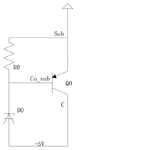wjxcom
Full Member level 5
Hi all, I'm designing a circuit as shown in figure 1:
Q196 is NPN transistor, the other transistors are PNP. The power voltage is 5V and 0V, the Base and Collector of Q343 is shorted together named netC who is connected to -5V.
When I simulate this circuit by SPECTRE, the current of Q321 and Q343 is about 85mA, but after tapeout, I test the chip, the the current of Q321 and Q343 is about 1A!! the current is so big.
Where does the big current come from? May be the circuit as shown in figure 1 is not correct? or something is wrong with Q321 and Q343? Q321 and Q343 have the same structor, the Cross-section of them is showned in figure 2,
E is emitter bipolar,
B is base bipolar,
C is collector bipolar,
Co_sub of Q 343 is connected to N1 as shown in figure 3
Co_sub of Q 321 is connected to N2 as shown in figure 3
In figure 3, Q1~Q4 are LPNP!
At the same time, the emitter area of Q343 and Q321 is big, the value is 12u*96u*3

Help me please, how can I decrease the current of Q343 and Q321? thanx!!
- - - Updated - - -
Because there have a negtive feedback loop (i.e. Q391,R55,Q196 and Q313), I don't think that the voltage value of net "netA" can be decreased, so the big current is NOT caused by "netA". In fact, "netA" is stable while I test the chip by the oscilloscope!
Q196 is NPN transistor, the other transistors are PNP. The power voltage is 5V and 0V, the Base and Collector of Q343 is shorted together named netC who is connected to -5V.
When I simulate this circuit by SPECTRE, the current of Q321 and Q343 is about 85mA, but after tapeout, I test the chip, the the current of Q321 and Q343 is about 1A!! the current is so big.
Where does the big current come from? May be the circuit as shown in figure 1 is not correct? or something is wrong with Q321 and Q343? Q321 and Q343 have the same structor, the Cross-section of them is showned in figure 2,
E is emitter bipolar,
B is base bipolar,
C is collector bipolar,
Co_sub of Q 343 is connected to N1 as shown in figure 3
Co_sub of Q 321 is connected to N2 as shown in figure 3
In figure 3, Q1~Q4 are LPNP!
At the same time, the emitter area of Q343 and Q321 is big, the value is 12u*96u*3

Help me please, how can I decrease the current of Q343 and Q321? thanx!!
- - - Updated - - -
Because there have a negtive feedback loop (i.e. Q391,R55,Q196 and Q313), I don't think that the voltage value of net "netA" can be decreased, so the big current is NOT caused by "netA". In fact, "netA" is stable while I test the chip by the oscilloscope!



